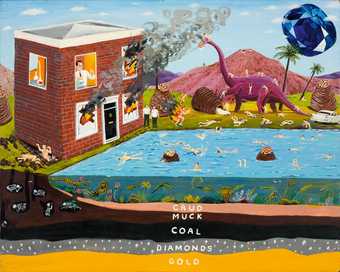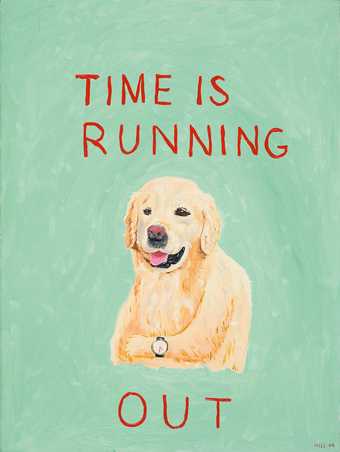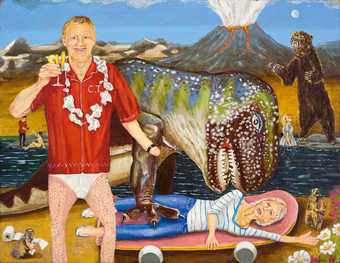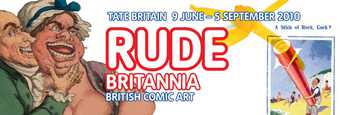Painting is a hobby for me. My wife is a proper artist and tells me I’m not supposed to say that, but I’m not afraid of being looked down on. I’d love to do it for a living, but I know deep down I’m not good enough. I tend to paint on the kitchen table in front of the TV or listening to the radio late at night. That’s why my paintings are all quite small; it’s also governed by the size of the piece of wood and the table, as I usually use bits of wood that I have found. Plywood’s my favourite. I was given a set of oil paints years ago and it took me a long time to work out how to use them. I found it frustrating how long the paint took to dry. Having never had a lesson, I was using them like watercolours – watering them down with turpentine, which gives you a very dull finish. About ten years ago I was a guest on Frank Skinner’s chat show and my reward was a box of quick-drying oil paints, which changed the whole thing. Now I can do a bit of painting, leave it on the radiator overnight and it’s dry by the morning. I tried acrylics, but I like the smell of the oil paint. I use art as a form of occupational therapy. You can switch off when you’re painting, all you think about is the job in hand. I’d recommend it to workaholics everywhere.

Harry Hill
Is Progress Really Necessary? 2006
Oil on Board
46 x 57.5cm
I usually work from photos in magazines – Hello!, OK! – and the Daily Mail is a particularly good source. When I see a photo I like, I tear it out and put it in a folder, and when I fancy doing a painting, I go through the folders and find a good image. I’m very fond of the picture of a dog called Solomon. His owners were on holiday on the Isle of Wight and he went missing. He was found – after he had swum from the Isle of Wight to Southampton. These paintings are sort of what Solomon might have been thinking on that swim.
I’ve done a few paintings of Solomon. And I’ve started to make him do different things. In one painting he is wearing my watch. More recently, I’ve been painting X Factor judges. I’ve got this book about circuses with loads of bearded ladies in it – it reminded me a bit of Peter Blake’s pictures of wrestlers. I had a picture of Sharon Osbourne and I combined the two. Then my wife Magda suggested that I should paint the other judges as circus acts. I think Simon Cowell is a modern P.T. Barnum. There’s a strong element of the freak show and spectacle about The X Factor.

Harry Hill
Time Is Running Out
Oil on board
61 x 46 cm
I like painting figures from popular culture because of the fleeting nature of fame. I did the Chris Tarrant paintings when there was all that fuss about him in the papers after he cheated on Ingrid. So I’m painting an imagined fall from grace. Before that I did one of Anthea Turner when she split up from her husband, which at the time was a really big story. Now we’re thinking – what was all the fuss about? I like the idea of the trivial being elevated to art. I have also painted a Mr Blobby-like character whose name is Parker Bowles-Windsor. He is the child of Charles and Camilla. To me he looks like a Philip Guston figure – a messy pink lump. I think it’s quite a funny idea.

Harry Hill
The Descent of Chris Tarrant Into Hell 2007
Oil on board 44 x 57 cm
Courtesy the artist © Harry Hill
I really like naïve artists such as Howard Finster, who did the Talking Heads Little Creatures album cover. And I like finding paintings in junk shops – I’ve got a really nice one called Bruce of a dog in a straw hat. It strikes me that a lot of modern art provokes the reaction of laughter or a smile. Some art – to me, anyway – seems to be a deliberate joke, often a punchline to a set-up which we have to imagine for ourselves. Sometimes artists fight against this and say that it isn’t their intention. In art, it seems it’s often important to appear to be serious. For instance, Maurizio Cattelan’s sculpture of the Pope felled by a meteorite (The Ninth Hour 1999) looks to me like a brilliant visual gag, worthy of Monty Python. Even works such as Damien Hirst’s cow’s head with the flies (A Thousand Years 1990) – there’s something quite darkly funny about that. It’s a black joke. That piece in the basement of The Saatchi Gallery – the world leaders in their wheelchairs bumping into each other (Sun Yuan and Peng Yu, Old Persons Home 2007) – was a great idea, fascinating, and you had to smile when you saw it. If you’re looking for a humour/art crossover, then I think David Shrigley’s stuff is spot on. I like the childlike aspect of it, and there’s a lot of irony. It looks easy, but it’s a tricky thing to get right, and a lot of people have tried to copy him. You look at some of his stuff and think “I could do that”, but actually, like all great art, all the bits have to be in the right place for it to work. I think being an artist is a higher calling than a comedian, because the comedian has to respond to his or her audience. In comedy, I’ve had many jokes which I thought were really funny, but if the audience doesn’t laugh, you end up having to drop them. An artist can do what he or she likes. You may not sell many paintings, but you’re still an artist.

